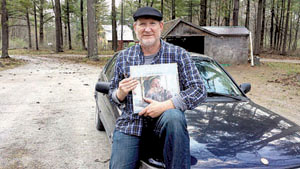Miler likes area’s history and its diversity

EMMY award winning art director Edward Rubin’s new book is about Vermont.
Edward Rubin is a fourth-generation Angeleno. His parents built a home on Alta Vista in 1934, near where he lives today with his husband of 26 years, poet Sam Ambler.
“My grandmother supervised the construction to make sure that all the details that she wanted were perfect,” he said.
As a child, his mom would take him to Van de Kamp’s Bakery on Wilshire Blvd., and the Farmers Market on Fairfax.
“I used to visit Santa Claus at the May Company at Christmas, and play in the park at the Tar Pits. I even remember the old Carthay Circle movie theatre.
“I never expected that, decades later, I would purchase a home in the neighborhood where my family is from… but I knew that the Miracle Mile was perfect for us.
“We wanted a neighborhood that had an identity, a history, a diverse population, and where you could walk to stores easily, and was also near a major cultural institution. LACMA certainly fulfilled that wish!
“Every time we walk in our neighborhood, even after 19 years, we still talk about how lucky we are to live here. There is so much going on, and it is all at our fingertips. The Miracle Mile has the best of living right in the middle of a major
His first book, however, takes a look at a different place: “Vermont, an Outsider’s Inside View.”
The Emmy-award winning art director, artist and internationally exhibited photographer first visited the picturesque state when working on an independent film in 1998.
He became friends with a seventh-generation Vermonter. “I realized that I needed to photograph the special world [he] was showing me—the real world of Vermonters who live and work there and love it,” he said.
Funding the four-year project on a home equity loan, Rubin interviewed and snapped 20,000 photographs of the state’s inhabitants—from the state governor to its farmers, artists, mechanics, supreme court justices, waitresses and activists.
“I had no plan—I photographed friends, and then friends of friends, and then strangers,” he said.
The artistic journey took him to Verona, Italy, where he helped guide the printing for the project. The result is the coffee-table-sized, 228-page book featuring 200 color and black-and-white photographs, recently published by Fine Arts Press.
“I believe my book will become a lasting, classic document of a very particular place and time, and also a record of perhaps what is being lost now in the United States—a sense of community,” he says.
Category: People


